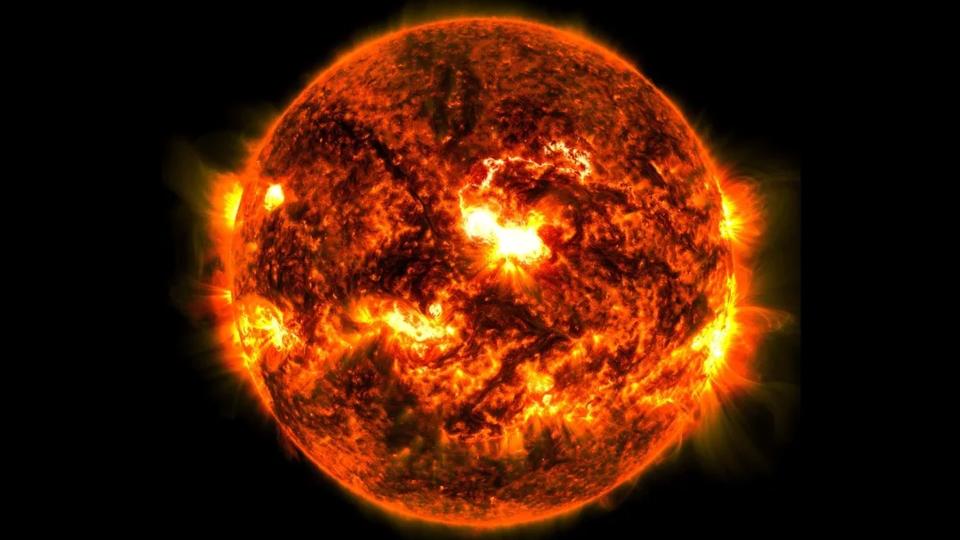When you buy through links on our articles, Future and its syndication partners may earn a commission.


Get ready, aurora chasers: There’s a good chance you’ll be able to catch a nice light show by the end of the week!
Forecasters with the U.S. National Oceanic and Atmospheric Administration (NOAA)’s Space Weather Prediction Center (SWPC) are highlighting the potential for a severe geomagnetic storm on Thursday (Oct. 10) and Friday (Oct. 11). That storm is likely to be in the G4 class — the second-highest level on the SWPC’s geomagnetic storm scale, which takes into account both severity and potential impacts.
Indeed, the SWPC has issued a G4 geomagnetic storm warning — the second one they’ve released since 2005. The other came this past May, in advance of a storm that spawned incredibly dramatic auroral displays.
The culprit? Another massive explosion from the sun.
On Tuesday night (Oct. 8), the sunspot AR 3848 produced a strong X1.8-class solar flare. X flares are the most powerful type of flare, and this one triggered radio blackouts across sunlit parts of Earth. SWPC forecasters analyzed the flare using data gathered by the Solar and Heliospheric Observatory (SOHO) spacecraft and determined that it was accompanied by a coronal mass ejection (CME), a huge eruption of solar particles and magnetic fields. And that CME is directed toward Earth, and is expected to trigger a powerful geomagnetic storm when it hits us.
“If you think of two magnets and they have the same polarity, and [you] try to put them together, they repel. If they’re opposite, they connect, and the magnets will stay together. It’s the same thing here,” Shawn Dahl, service coordinator for the SWPC, said at a press conference on Wednesday (Oct. 9).
“If the magnetic field in the CME is the same as Earth’s, we will have an initial impact in effect and immediate enhancement in geomagnetic response, but we probably will not reach those severe levels or potentially higher,” Dahl added. “If it’s favorably connected as it comes through or changes into that configuration throughout its passage, then we will escalate in responses. That’s where the true potential will come in, and we can issue our warnings and subsequent alerts as we reach those levels of activity.”
Related: The worst solar storms in history
According to SWPC forecasters, this CME is racing toward Earth at speeds between 2.7 million miles per hour and 2.9 million miles per hour (4.3 million kilometers per hour to 4.7 million kilometers per hour) — the fastest one they’ve seen in a while, Dahl said. It could hit our planet’s magnetic field as early as Thursday morning.
“It’s a shock front that arrives here at Earth first, like a strong cold front moving across the U.S. You suddenly get a blast of enormous wind, but it may take a while for the extreme cold temperatures to show up. It’s a similar thing with these CMEs,” Dahl said.
“We get the shock front arrival and immediate jump-up of speed and strengthen[ing] of the magnetic field,” Dahl added. “The strongest part of the magnetic field, like the extreme cold temperatures, may not show up for a bit because that’s in that magnetic cloud portion as it rolls and passes over Earth. For those who are monitoring it and see that we had an arrival, but then things look like they’re settling down, they are not. We still have the magnetic cloud to pass over Earth, so keep that in mind.”
Strong geomagnetic storms can disrupt radio communications and power grids and even damage orbiting satellites. But they can also boost the auroras, also known as the northern and southern lights, making them more intense and viewable at lower latitudes than usual.
RELATED STORIES:
— Where and when to see the northern lights in 2024
— Watch a 100,000-mile-high tower of plasma erupt from the sun in this stunning video
— ‘A lot has changed’: NOAA is rewriting the book on how to rank solar storms
However, uncertainty is always involved with auroras. Forecasters say that if the coming geomagnetic storm strengthens and progresses into the evening, observers in central eastern states, the lower Midwest and Northern California could have a chance to see auroral displays. To get an idea of how things are progressing, you can monitor the SWPC website, use tools like the 30-minute forecasts and watch for ground-truth reports on social media.
“You need us to be ready to roll and monitor our web page, that real-time solar wind in particular,” Dahl said. “Be cognizant and maybe subscribe to the actual alerts so you know when activities are taking place. What you’re going to be looking for is the enhanced magnetic field, which we expect to have, and what’s that orientation. If it’s staying northward, it’s not as likely to progress further southward. But, if it goes to opposite Earth — southward, as we call it — that’s when things will rapidly spin up and the aurora is most likely.”
Forecasters also stress that no two storms are alike, and there’s still much to determine about this one as it approaches Earth.
“Will this be a global phenomenon or seen across the United States, such as the May storm?” Dahl said. “It’s tough to say until we get a good read on it. We would really need to reach those G5 levels for that to happen again, and we do have a chance for that.”
